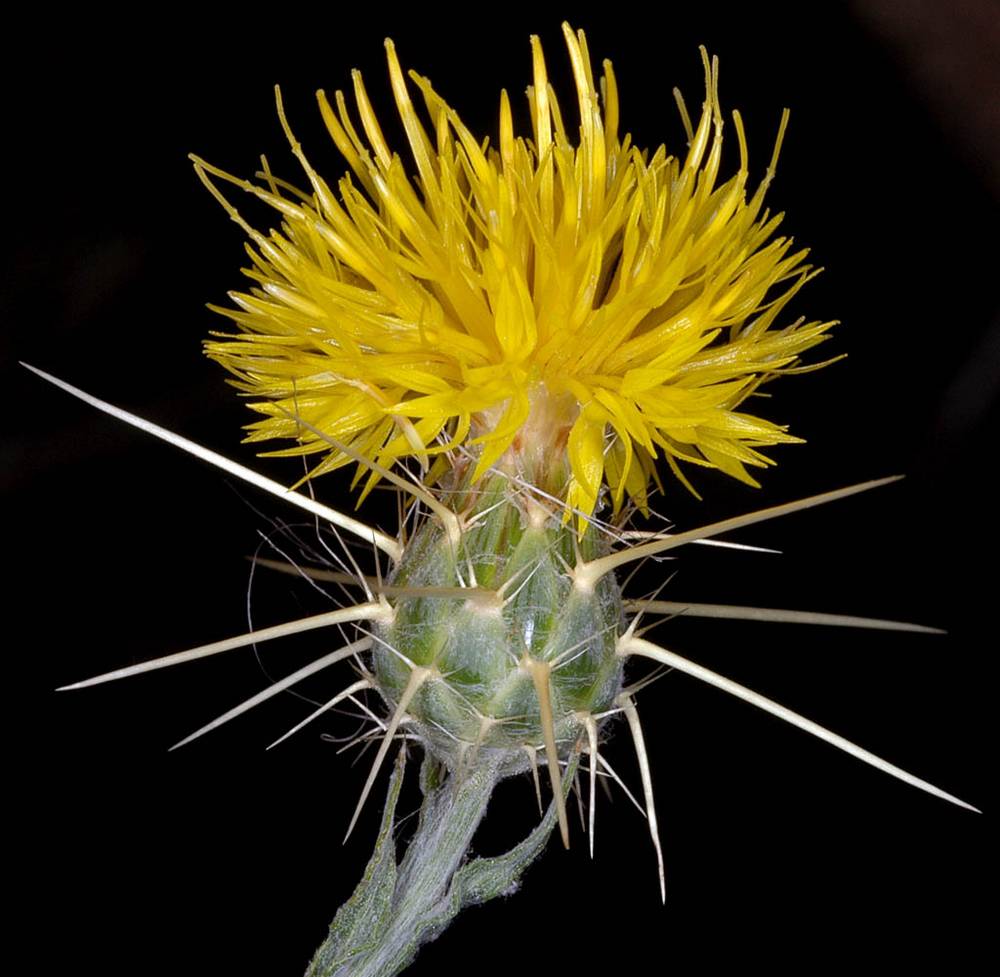Centaurea melitensis
Centaurea solstitialis
Maltese starthistle, tocalote
St. Barnaby's thistle, yellow starthistle
branched above, sparsely tomentose;
gland-dotted.
1–many, branched from bases, tomentose.
villous, thinly to densely tomentose;
gland-dotted;
basal and lower cauline blades oblong to oblanceolate, 2–15 cm;
margins dentate, pinnately lobed or entire, petiolate to tapering at base; upper cauline blades linear to oblong, 1–5 cm, bases decurrent;
margins dentate to entire.
tomentose and scabrous to bristly, bases decurrent;
basal and lower cauline blades often absent at maturity, 5–15 cm, pinnately dissected or lobed;
petioles winged; upper cauline blades oblong to linear, 1–10 cm;
margins entire or slightly dentate, sessile.
1–few in corymb-like arrays or heads solitary.
cyme-like clusters or heads solitary.
ovoid, 8–15 mm.
ovoid, 10–15 mm.
yellow, sterile florets ? fertile florets, fertile florets 10–14 mm.
yellow, sterile florets ? fertile florets, fertile florets 13–20 mm.
outer ovate, bases spiny-fringed;
surfaces tomentose to glabrate;
central spines slender, 5–10 mm, often purple; inner entire; acute or spine-tipped.
outer ovate;
bodies green, palmately spiny;
central spines stout, 10–25 mm; straw-colored; inner with smaller hyaline appendages.
2.5–3 mm, white or light brown, finely hairy, pappi of unequal, white bristles, 1.5–3 mm.
dimorphic; outer 2–3 mm, dark brown, glabrous;
pappi 0; inner light brown or mottled, pappi of white bristles, 2–4 mm.
disciform.
disciform, pedunculate.
=24.
=16.
Centaurea melitensis
Centaurea solstitialis
Disturbed areas, roadsides, open woods, fields, pastures. Flowering May–Jul. 0–700 m. CR, ECas, Est, Sisk, WV. CA, ID, NV, WA; scattered in North America; Africa, Asia, Europe. Exotic.
Disturbed areas, roadsides, woods, fields, pastures, streambanks. Flowering Jul–Oct. 0–2000 m. BR, BW, Col, CR, Est, Lava, Sisk, WV. CA, ID, NV, WA; throughout North America; Europe. Exotic.
Centaurea solstitialis is an aggressive weed of pastures and rangeland in western North America, often forming dense stands. This species is cumulatively toxic to horses, potentially causing a disorder known as “chewing disease.” See also C. × gerstlaueri.
Bridget Chipman
Bridget Chipman
- Local floras:
BC,
CA,
OR,
WA
- Local Web sites:
CalFlora,
CalPhotos,
Flora NW,
PNW Herbaria
WildflowerSearch
iNaturalist (observations)
USDA Plants Database
- LBJ Wildflower Center
- SEINet
- Plants of the World Online
- Encyclopedia of Life
- Wikipedia
- Google Image Search
- Local floras:
BC,
CA,
OR,
WA
- Local Web sites:
CalFlora,
CalPhotos,
Flora NW,
PNW Herbaria,
Turner Photog.
WildflowerSearch
iNaturalist (observations)
USDA Plants Database
- LBJ Wildflower Center
- SEINet
- Plants of the World Online
- Encyclopedia of Life
- Wikipedia
- Google Image Search





